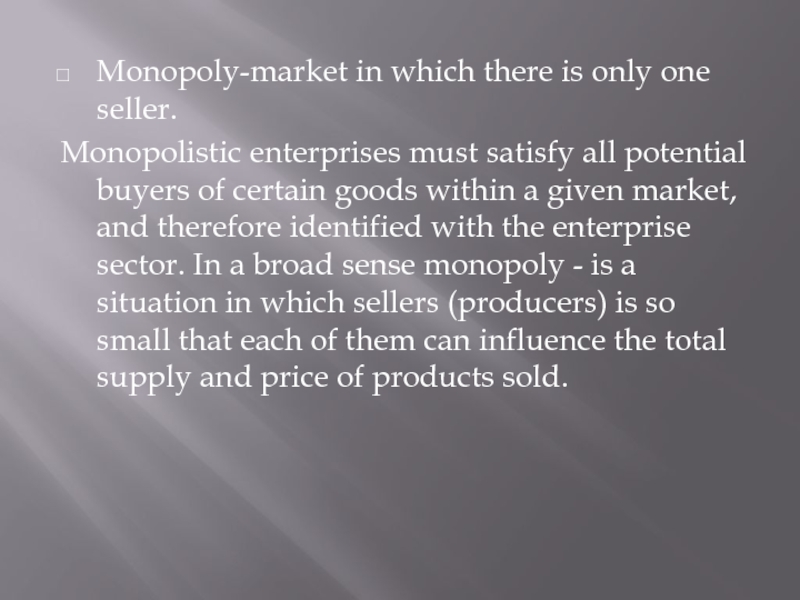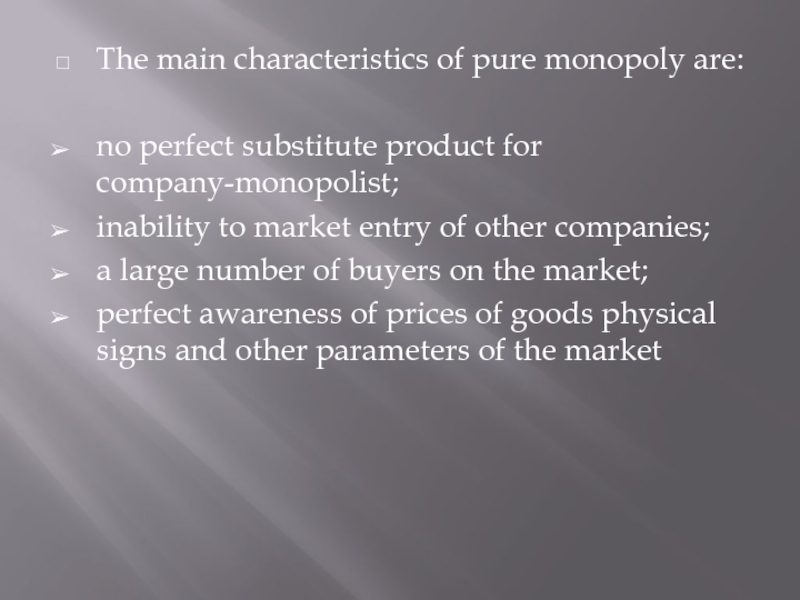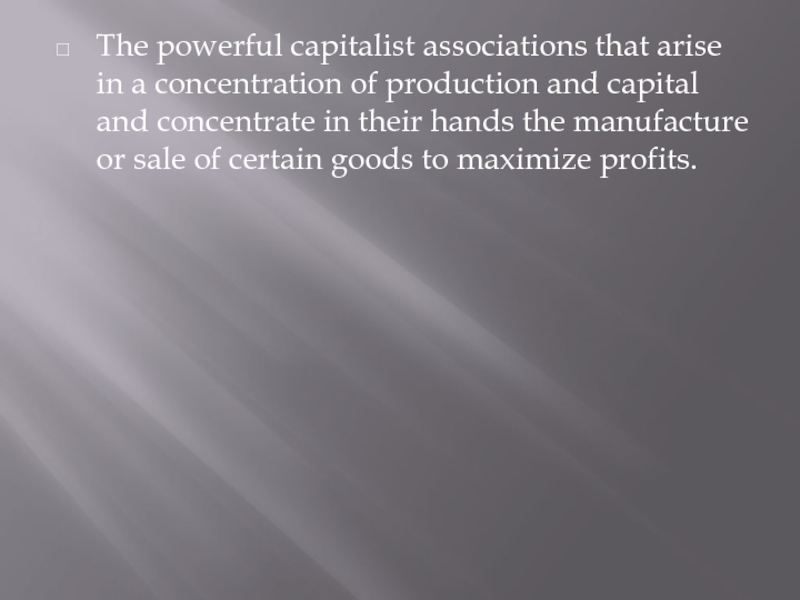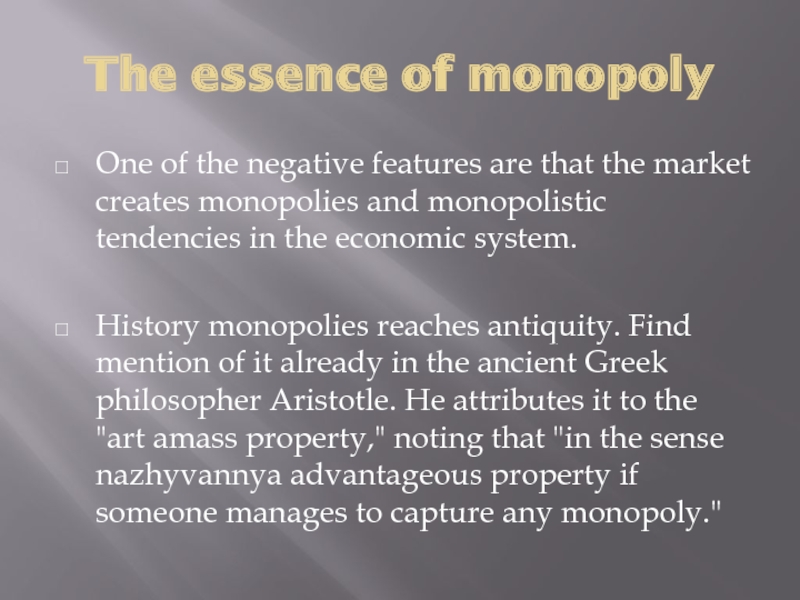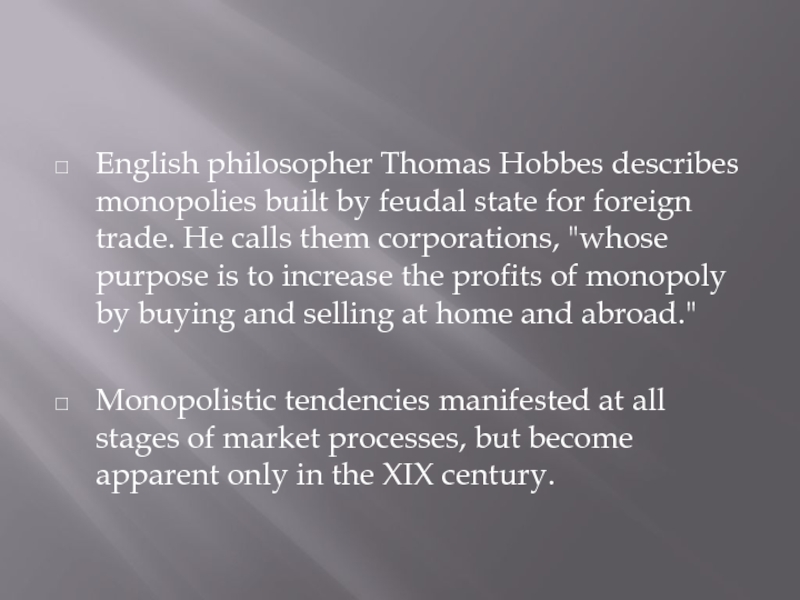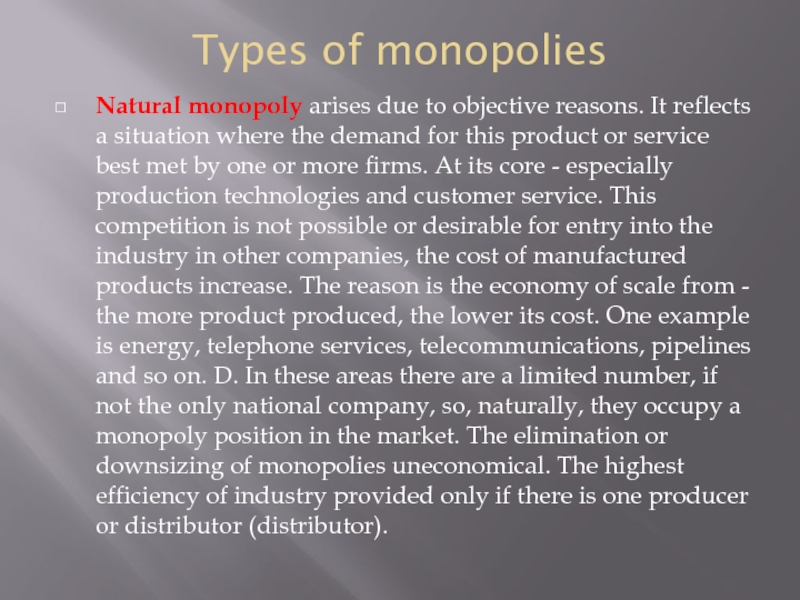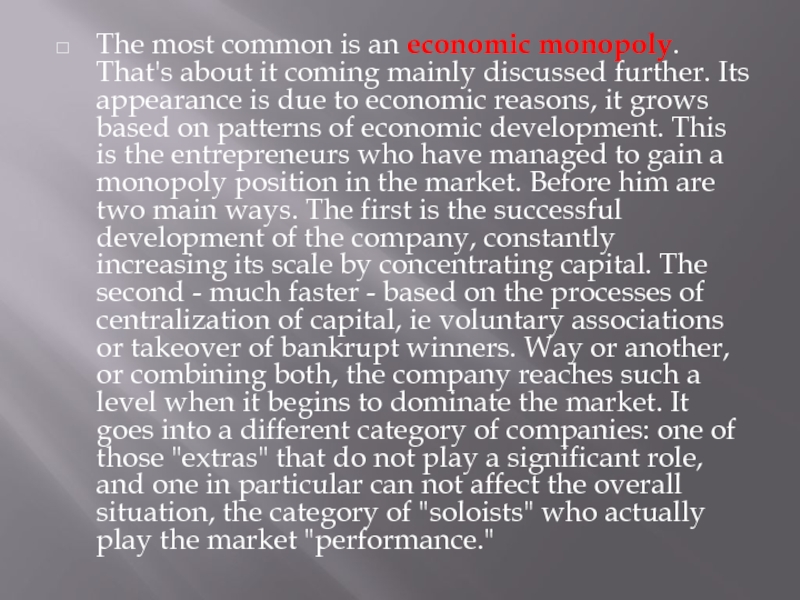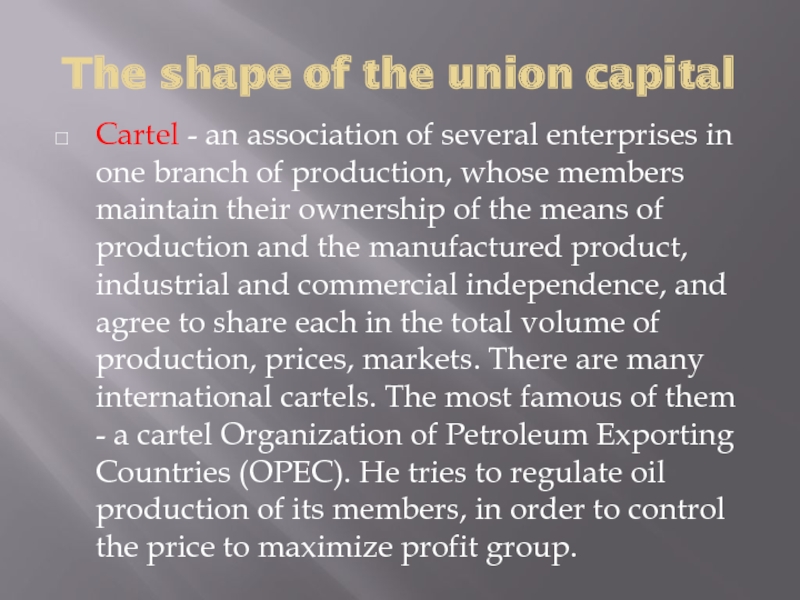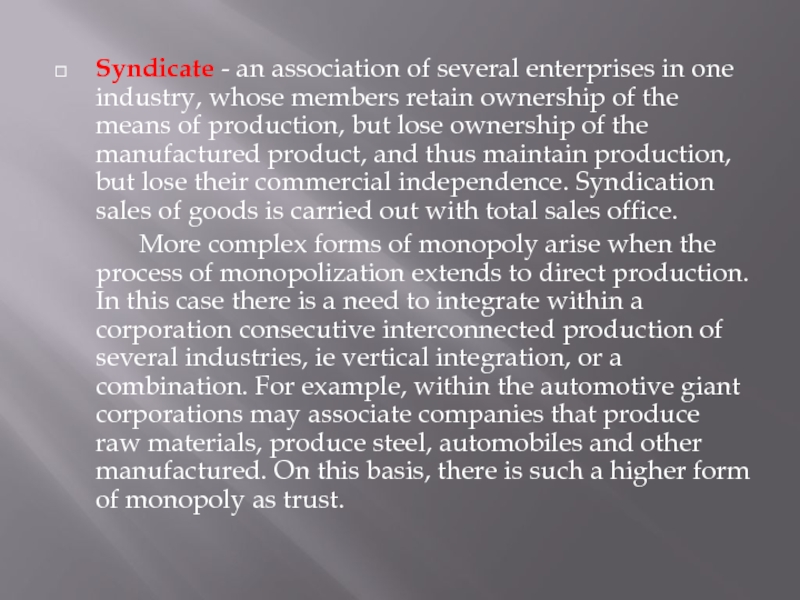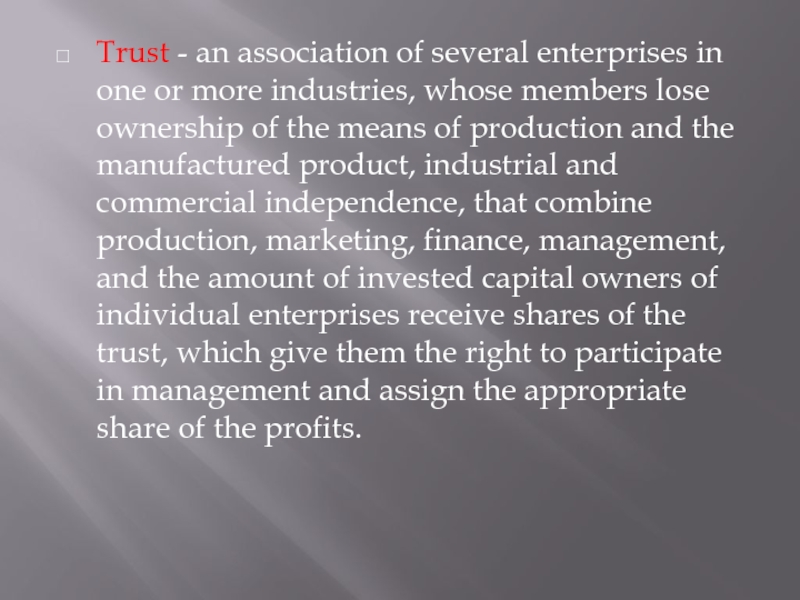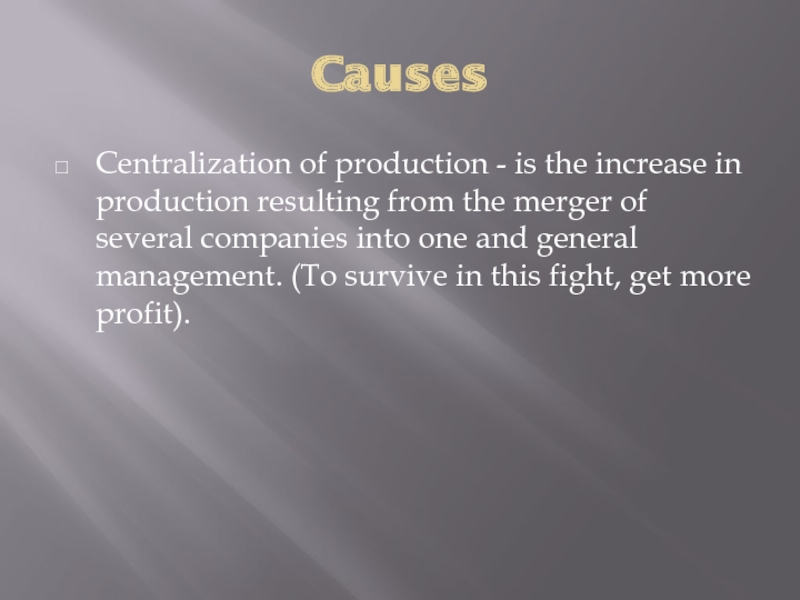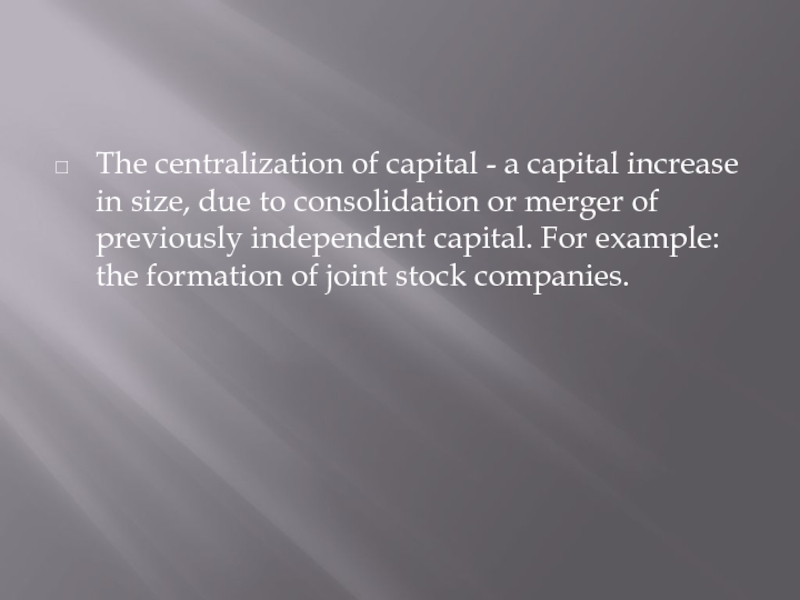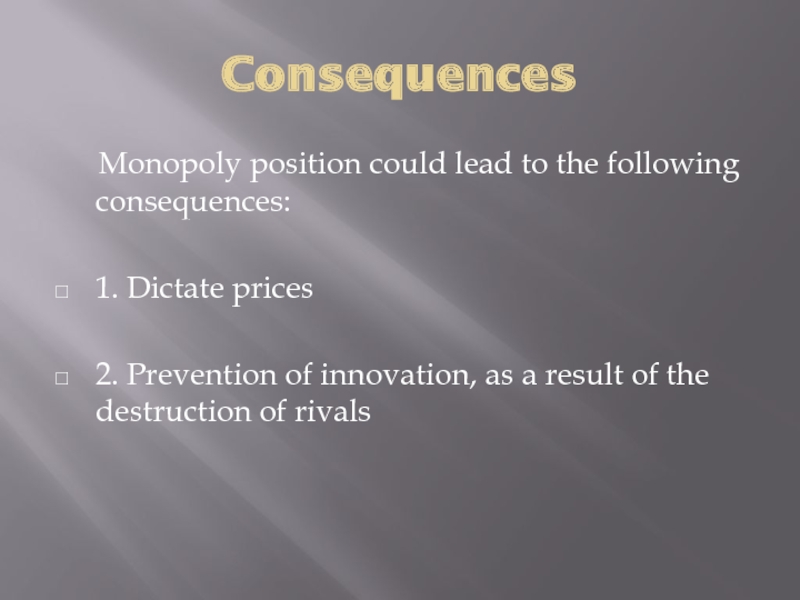- Главная
- Разное
- Дизайн
- Бизнес и предпринимательство
- Аналитика
- Образование
- Развлечения
- Красота и здоровье
- Финансы
- Государство
- Путешествия
- Спорт
- Недвижимость
- Армия
- Графика
- Культурология
- Еда и кулинария
- Лингвистика
- Английский язык
- Астрономия
- Алгебра
- Биология
- География
- Детские презентации
- Информатика
- История
- Литература
- Маркетинг
- Математика
- Медицина
- Менеджмент
- Музыка
- МХК
- Немецкий язык
- ОБЖ
- Обществознание
- Окружающий мир
- Педагогика
- Русский язык
- Технология
- Физика
- Философия
- Химия
- Шаблоны, картинки для презентаций
- Экология
- Экономика
- Юриспруденция
Monopoly презентация
Содержание
- 1. Monopoly
- 2. Monopoly-market in which there is only one
- 3. The main characteristics of pure monopoly are:
- 4. The powerful capitalist associations that arise in
- 5. The essence of monopoly One of the
- 6. English philosopher Thomas Hobbes describes monopolies
- 7. Types of monopolies Natural monopoly
- 8. Administrative monopoly is caused by the actions
- 9. The most common is an economic monopoly.
- 10. The shape of the union capital Cartel
- 11. Syndicate - an association of several enterprises
- 12. Trust - an association of several enterprises
- 13. Causes of monopolies associated primarily with changes
- 14. Causes Centralization of production - is the
- 15. The centralization of capital - a
- 16. As a result of government actions (intentional or her special steps).
- 17. The emergence of shareholder capitalist property
- 18. Economic crisis.
- 19. Consequences Monopoly position could
- 20. Thank you!
Слайд 2Monopoly-market in which there is only one seller.
Monopolistic enterprises must satisfy
all potential buyers of certain goods within a given market, and therefore identified with the enterprise sector. In a broad sense monopoly - is a situation in which sellers (producers) is so small that each of them can influence the total supply and price of products sold.
Слайд 3The main characteristics of pure monopoly are:
no perfect substitute product for
company-monopolist;
inability to market entry of other companies;
a large number of buyers on the market;
perfect awareness of prices of goods physical signs and other parameters of the market
inability to market entry of other companies;
a large number of buyers on the market;
perfect awareness of prices of goods physical signs and other parameters of the market
Слайд 4The powerful capitalist associations that arise in a concentration of production
and capital and concentrate in their hands the manufacture or sale of certain goods to maximize profits.
Слайд 5The essence of monopoly
One of the negative features are that the
market creates monopolies and monopolistic tendencies in the economic system.
History monopolies reaches antiquity. Find mention of it already in the ancient Greek philosopher Aristotle. He attributes it to the "art amass property," noting that "in the sense nazhyvannya advantageous property if someone manages to capture any monopoly."
History monopolies reaches antiquity. Find mention of it already in the ancient Greek philosopher Aristotle. He attributes it to the "art amass property," noting that "in the sense nazhyvannya advantageous property if someone manages to capture any monopoly."
Слайд 6
English philosopher Thomas Hobbes describes monopolies built by feudal state for
foreign trade. He calls them corporations, "whose purpose is to increase the profits of monopoly by buying and selling at home and abroad."
Monopolistic tendencies manifested at all stages of market processes, but become apparent only in the XIX century.
Monopolistic tendencies manifested at all stages of market processes, but become apparent only in the XIX century.
Слайд 7Types of monopolies
Natural monopoly arises due to objective reasons. It
reflects a situation where the demand for this product or service best met by one or more firms. At its core - especially production technologies and customer service. This competition is not possible or desirable for entry into the industry in other companies, the cost of manufactured products increase. The reason is the economy of scale from - the more product produced, the lower its cost. One example is energy, telephone services, telecommunications, pipelines and so on. D. In these areas there are a limited number, if not the only national company, so, naturally, they occupy a monopoly position in the market. The elimination or downsizing of monopolies uneconomical. The highest efficiency of industry provided only if there is one producer or distributor (distributor).
Слайд 8Administrative monopoly is caused by the actions of public bodies. 3
one hand, the provision of individual companies the exclusive right to perform certain types of activity. Thus the Dutch and English East India Company in the early 17th century. the government granted exceptional right to trade with India. 3 other hand, this organizational structure for state enterprises when they are combined and are subject to different central boards, ministries, associations. There are usually grouped enterprise of a field they act in the market as a single economic entity and no competition between them. The economy of the former Soviet Union belonged to the most monopolized in the world. The dominant there was just an administrative monopoly, especially the all-powerful monopoly of ministries and agencies. Moreover, there was an absolute state monopoly on the organization and management of the economy, which was based on the dominant state ownership of the means of production.
Слайд 9The most common is an economic monopoly. That's about it coming
mainly discussed further. Its appearance is due to economic reasons, it grows based on patterns of economic development. This is the entrepreneurs who have managed to gain a monopoly position in the market. Before him are two main ways. The first is the successful development of the company, constantly increasing its scale by concentrating capital. The second - much faster - based on the processes of centralization of capital, ie voluntary associations or takeover of bankrupt winners. Way or another, or combining both, the company reaches such a level when it begins to dominate the market. It goes into a different category of companies: one of those "extras" that do not play a significant role, and one in particular can not affect the overall situation, the category of "soloists" who actually play the market "performance."
Слайд 10The shape of the union capital
Cartel - an association of several
enterprises in one branch of production, whose members maintain their ownership of the means of production and the manufactured product, industrial and commercial independence, and agree to share each in the total volume of production, prices, markets. There are many international cartels. The most famous of them - a cartel Organization of Petroleum Exporting Countries (OPEC). He tries to regulate oil production of its members, in order to control the price to maximize profit group.
Слайд 11Syndicate - an association of several enterprises in one industry, whose
members retain ownership of the means of production, but lose ownership of the manufactured product, and thus maintain production, but lose their commercial independence. Syndication sales of goods is carried out with total sales office.
More complex forms of monopoly arise when the process of monopolization extends to direct production. In this case there is a need to integrate within a corporation consecutive interconnected production of several industries, ie vertical integration, or a combination. For example, within the automotive giant corporations may associate companies that produce raw materials, produce steel, automobiles and other manufactured. On this basis, there is such a higher form of monopoly as trust.
More complex forms of monopoly arise when the process of monopolization extends to direct production. In this case there is a need to integrate within a corporation consecutive interconnected production of several industries, ie vertical integration, or a combination. For example, within the automotive giant corporations may associate companies that produce raw materials, produce steel, automobiles and other manufactured. On this basis, there is such a higher form of monopoly as trust.
Слайд 12Trust - an association of several enterprises in one or more
industries, whose members lose ownership of the means of production and the manufactured product, industrial and commercial independence, that combine production, marketing, finance, management, and the amount of invested capital owners of individual enterprises receive shares of the trust, which give them the right to participate in management and assign the appropriate share of the profits.
Слайд 13Causes of monopolies associated primarily with changes in the technological mode
of production. A prerequisite for this change was the Industrial Revolution late. XVIII - early. XIX century., Technical inventions, new industries and the rapid development of production in many of them, especially in the light industry.
A process of concentration of production, when the company, instead of doing one another grueling competition, enter into an agreement that is united and capital.
A process of concentration of production, when the company, instead of doing one another grueling competition, enter into an agreement that is united and capital.
Слайд 14Causes
Centralization of production - is the increase in production resulting from
the merger of several companies into one and general management. (To survive in this fight, get more profit).
Слайд 15
The centralization of capital - a capital increase in size, due
to consolidation or merger of previously independent capital. For example: the formation of joint stock companies.
Слайд 17
The emergence of shareholder capitalist property where individual private property becomes
a brake on the productive forces. This means that at the end of the XIX century. under the influence of scientific inventions (new types of engines and t. e.) needed to build such plants, which was unable to build any capitalist. In addition, now begins the construction of railroads and other large objects. To gain the necessary funds separate capitalist could perhaps through the decades. There is a need for a new form of property that would be able to quickly solve these problems. She became a joint-stock capitalist property resulting from the merger, combining multiple capitalists.
Слайд 19Consequences
Monopoly position could lead to the following consequences:
1.
Dictate prices
2. Prevention of innovation, as a result of the destruction of rivals
2. Prevention of innovation, as a result of the destruction of rivals

